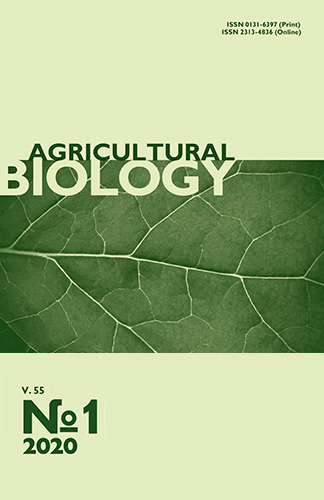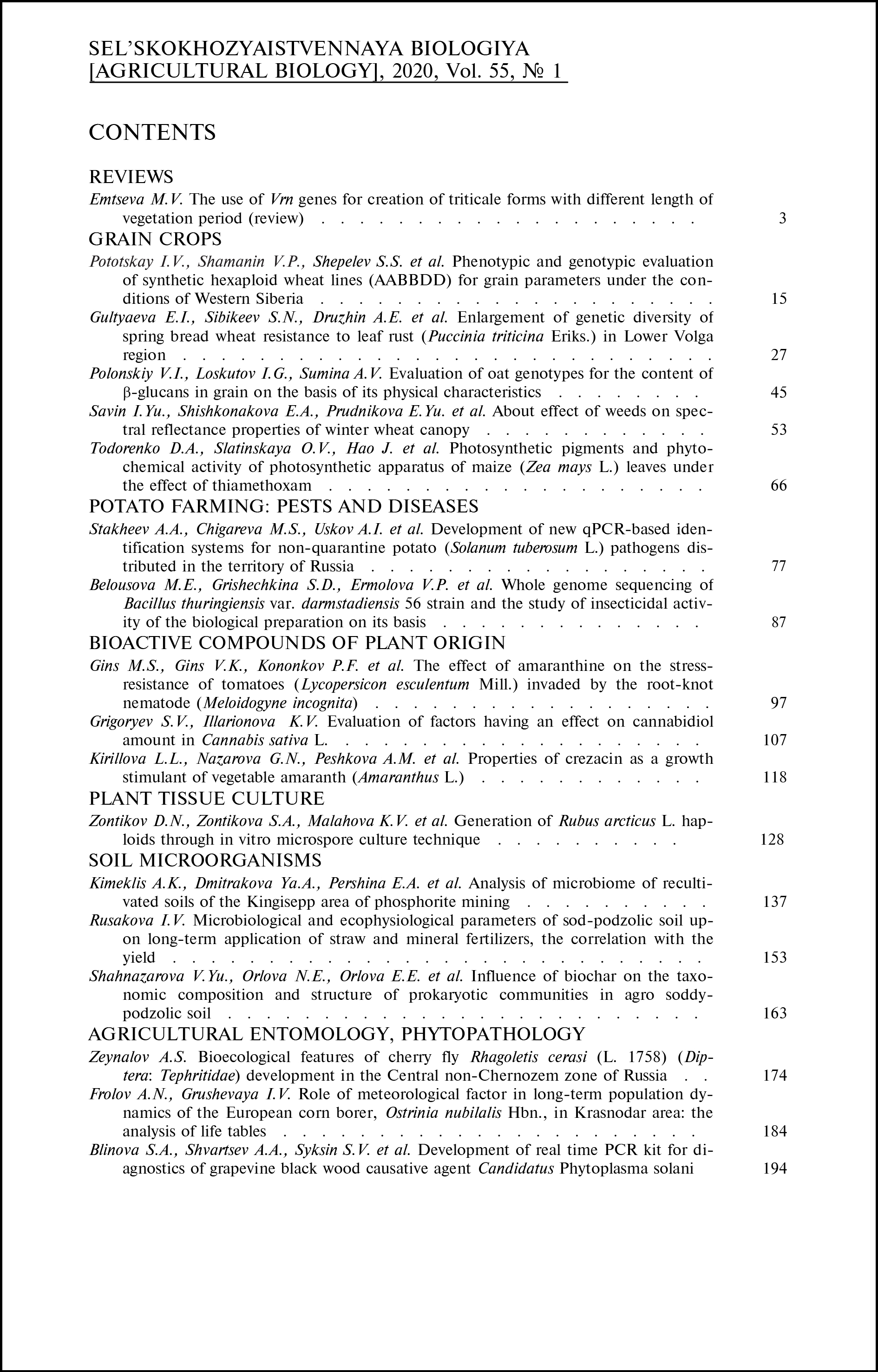doi: 10.15389/agrobiology.2020.1.194eng
UDC: 634.8:632.08:577.2
Acknowledgements:
The studies were carried out as part of the VNNIIViV Magarach RAS State Task No. 0833-2015-0019.
DEVELOPMENT OF REAL TIME PCR KIT FOR DIAGNOSTICS
OF GRAPEVINE BLACK WOOD CAUSATIVE AGENT
Candidatus Phytoplasma solani
S.A. Blinova1, A.A. Shvartsev1, S.V. Syksin1, G.N. Bondarenko2, I.G. Bashkirova2, S.M. Gorislavets3, V.I. Risovannaya3, E.P. Stranishevskaya3, V.A. Volodin3, Ya.I. Alekseev1, 3, 4
1LLC Syntol, 42, Timiryazevskaya ul., Moscow, 127434 Russia, e-mail Sofya.blinova@yandex.ru (✉ corresponding author), alexey.sva@yandex.ru, stason_16@inbox.ru, jalex@syntol.ru;
2All-Russian Plant Quarantine Center, 32, ul. Pogranichnaya, pos. Bykovo, Ramenskii Region, Moscow Province, 140150 Russia, e-mail reseachergm@mail.ru, bashkirovaid@mail.ru;
3National Research Institute for Grape and Wine Magarach RAS, 31, ul. Kirova, Yalta, Republic of Crimea, 298600 Russia, e-mail mgr.magarach@gmail.com, stranishevskayaelena@gmail.com, vitaliivolodin1988@gmail.com;
4Institute for Analytical Instrumentation RAS, 31-33, ul. Ivana Chernyh, St. Petersburg, 198095 Russia, e-mail jalex@syntol.ru
ORCID:
Blinova S.A. orcid.org/0000-0001-6782-8353
Gorislavets S.M. orcid.org/0000-0002-6749-8048
Shvartsev A.A. orcid.org/0000-0002-2786-9860
Risovannaya V.I. orcid.org/0000-0003-2208-798X
Syksin S.V. orcid.org/0000-0002-2753-3857
Stranishevskaya E.P. orcid.org/0000-0002-2840-5638
Bondarenko G.N. orcid.org/0000-0002-3826-1009
Volodin V.A. orcid.org/0000-000-2842-6092
Bashkirova I.G. orcid.org/0000-0001-9014-4179
Alekseev Ya.I. orcid.org/0000-0002-1696-7684
Received October 16, 2019
Today, phytoplasmas are causative agents of about three hundred different plant diseases. The greatest damage in European vineyards is due to two types of phytoplasmas, Candidatus Phytoplasma vitis Marzorati et al. 2006, the pathogen of flavescence dorée of grapevine, and Candidatus Phytoplasma solani Qualino et al., 2013, the causative agent of black wood of grapevine. Phytoplasma damage of vineyards can lead to crop losses of up to 25-30 %, and when infected up to 70 %, the vineyards should be completely uprooted. Symptoms of various phytoplasma diseases in grape are similar with each other and with viral and bacterial diseases that makes their visual differentiation to species impossible. The wide spread and high damage by phytoplasma diseases require deeper research of phytoplasma epidemiology and relevant molecular genetic diagnostic methods for monitoring phytopathogen in planting material. We have developed the first Russian kit for detection these pathogens by real-time polymerase chain reaction (Real-Time PCR) which allows effective identification of Candidatus Phytoplasma solani. A comparison of the developed kit with the recommended primers and probes for Real-Time PCR has shown a higher sensitivity and specificity as compared to existing diagnostic PCR systems. The goal of this work was to develop and test a kit for the detection of Candidatus Phytoplasma solani by the real-time polymerase chain reaction (qPCR). Candidatus Phytoplasma solani DNA samples and infected grape vines, roots and leaves of Chardonnay, Pinot noir and Bastardo Magarachsky varieties with visual signs of infection collected in the autumn of 2018 from the vineyards of the South Coast region of the Crimean peninsula were tested. Phytoplasma DNA was extracted as recommended by EPPO, with modifications, as well as with Cytosorb reagent kit (Syntol LLC, Russia). A pair of primers, SolaSeq_F 5'-AACTTAACCTTTTAACTAGGGC-3' and SolaSeq_R 5'-CATCAAGGCATTTGCC-3', was designed for Candidatus Phytoplasma solani DNA sequencing. To estimate the analytical sensitivity of the test system, a vector construct based on the Pal2T plasmid (Evrogen, Russia) was created with the insertion of the Candidatus Phytoplasma solani target 119 bp fragment of SecY gene. The sequence of SecY gene is conservative, unlike other genes recommended for diagnosis. The designed primers allow identification of all Candidatus Phytoplasma solani strains which sequences we found in the GenBank NCBI Nucleotide database on January 16, 2019. The developed reagent kit was tested using various Real-Time PCR instruments. We have assessed the main characteristics of the reagent kit, i.e. sensitivity, specificity, and reproducibility. Analytical sensitivity of the developed test system isn’t less than 15 copies per PCR reaction. The analytical specificity was 100 % when tested with 37 closely related and accompanying microorganisms, as well as four samples of grapes suspected to be infected by Candidatus Phytoplasma solani. There were no false-positive results in the analysis of other types of phytoplasmas and related microorganisms. Also, in analyzing target organism DNA samples, false-negative results were not found. The developed kit was tested on 194 samples of grapes suspected of being infected by Candidatus Phytoplasma solani. The specificity of Candidatus Phytoplasma solani detection was confirmed in all cases by DNA sequencing of positive samples. The developed kit allows rapid, accurate and high sensitive DNA identification of Candidatus Phytoplasma solani in plants at all stages of their vegetative development, including planting material, and can also be used for full-scale screening studies.
Keywords: phytoplasma, Candidatus Phytoplasma solani, grapes, real-time PCR, diagnostics, qPCR test kit, specificity, sensitivity, reproducibility, repeatability.
REFERENCES
- Matyashova G.N., Zaets V.G. Vestnik Rossiiskogo universiteta druzhby narodov. Seriya: Agronomiya i zhivotnovodstvo, 2015, 4: 7-14 (in Russ.).
- Risovannaya V.I., Gorislavets S.M., Volodin V.A. Magarach. Vinogradarstvo i vinodelie, 2013, 4: 6-8 (in Russ.).
- Doi Y., Teranaka M., Yora K., Asuyama H. Mycoplasma- or PLT group-like microorganisms found in the phloem elements of plants infected with mulberry dwarf, potato witches’ broom, aster yellows, or Paulownia witches’ broom. Annals Phytopathological Society, 1967, 33(4): 259-266 CrossRef
- Duduk B., Bertaccini A. Phytoplasma classification: taxonomy based on 16S ribosomal gene, is it enough? Phytopathogenic Mollicutes,2011, 1(1): 3-13 CrossRef
- Deng S., Hiruki C. Amplification of 16S rRNA genes from culturable and nonculturable Mollicutes. Journal of Microbiological Methods, 1991, 14(1): 53-61 CrossRef
- Lee I.M., Davis R.E., Hiruki C. Genetic interrelatedness among clover proliferation mycoplasma-like organisms (MLOs) and other MLOs investigated by nucleic acid hybridization and restriction fragment length polymorphism analyses. Applied and Environmental Microbiology, 1991, 57(12): 3565-3569.
- Duduk B., Perić P., Marčić D., Drobnjaković T., Picciau L., Alma A., Bertaccini A. Phytoplasmas in carrots: disease and potential vectors in Serbia. Bulletin of Insectology, 2008, 61(2): 327-331.
- The IRPCM Phytoplasma/Spiroplasma Working Team — Phytoplasma taxonomy group. ‘Candidatus Phytoplasma’, a taxon for the wall-less, non-helical prokaryotes that colonize plant phloem and insects. Internation Journal of Systematic and Evolutionary Microbiology, 2004, 54(4): 1243-1255 CrossRef
- Davies D.L., Lee I.-M. Cluster-specific polymerase chain reaction amplification of 16S rDNA sequences for detection and identification of mycoplasmalike organisms. Phytopathology, 1993, 83(7): 1008-1011 CrossRef
- Lee I.-M., Gundersen-Rindal D.E., Davis R.E., Bartoszyk I.M. Revised classification scheme of phytoplasmas based on RFLP analyses of 16S rRNA and ribosomal protein gene sequences. Internation Journal of Systematic and Evolutionary Microbiology, 1998, 48(4): 1153-1169 CrossRef
- Matyashova G.N., Zaets V.G. Vestnik Rossiiskogo universiteta druzhby narodov. Seriya: Agronomiya i zhivotnovodstvo, 2015, 4: 7-14 (in Russ.).
- PM 7/133 (1) Generic detection of phytoplasmas. EPPO Bulletin, 2018, 48(3): 414-424 CrossRef
- Hren M., Boben L., Rotter A., Kralj P., Gruden K., Ravnikar M. Real-time PCR detection systems for Flavescence dorée and Bois noir phytoplasmas in grapevine: comparison with conventional PCR detection and application in diagnostics. Plant Pathology, 2007, 56(5): 785-796 CrossRef
- Li W., Hartung J.S., Levy L. Quantitative real-time PCR for detection and identification of Candidatus Liberibacter species associated with citrus huanglongbing. Journal of Microbiological Methods, 2006, 66(1): 104-115 CrossRef
- PM 7/079 (2) Grapevine flavescence dorée phytoplasma EPPO Bulletin,2016, 46(1): 78-93 CrossRef
- Angelini E., Bianchi G.L., Filippin L., Morassutti C., Borgo M. A new TaqMan method for the identification of phytoplasmas associated with grapevine yellows by real-time PCR assay. Journal of Microbiological Methods,2007, 68(3): 613-622 CrossRef
- Berger J., Via J.D., Baric S. Development of a TaqMan allelic discrimination assay for the distinction of two major subtypes of the grapevine yellows phytoplasma Bois noir. European Journal of Plant Pathology, 2009, 124(3): 521-526 CrossRef
- Edinyi perechen' karantinnykh ob"ektov Evraziiskogo ekonomicheskogo soyuza. S izmeneniyami i dopolneniyami ot 30 marta 2018 g. (izmeneniya ot 2 maya 2018 g. — Reshenie Soveta Evraziiskoi ekonomicheskoi komissii ot 30 marta 2018 g. N 25) [Single list of quarantine facilities of the Eurasian Economic Union. With amendments and additions of March 30, 2018 (changes of May 2, 2018 — Decision of the Council of the Eurasian Economic Commission of March 30, 2018 N 25)]. Available: https://vniikr.ru/edinyij-perechen-karantinnyix-obektov-evrazijskogo-ekonomicheskogo-soyuza. Accessed: 14.04.2019 (in Russ.).
- Choueiri E., Jreijiri F., El Zammar S., Verdin E., Salar P., Danet J.L., Bové J., Garnier M. First report of grapevine “Bois Noir” disease and a new phytoplasma infecting solanaceous plants in Lebanon. Plant Disease, 2002, 86(6): 697-697 CrossRef
- Franova J. Difficulties with conventional phytoplasma diagnostic using PCR/PFLP analysis. Bulletin of Insectology, 2011, 64(Suppl.): S287-S288.
- Galetto L., Bosco D., Merzachi C. Universal and group-specific real-time PCR diagnosis of flavescence dorée (16Sr-V), bois noir (16Sr-XII) and apple proliferation (16Sr-X) phytoplasmas from field-collected plant hosts and insect vectors. Annals of Applied Biology, 2005, 147(2): 191-201 CrossRef
- Plavec J., Križanac I., Budinšćak Ž., Škorić D., Music M.S. A case study of FD and BN phytoplasma variability in Croatia: multigene sequence analysis approach. European Journal of Plant Pathology, 2015, 142(3): 591-601 CrossRef
- Bogoutdinov D.Z., Kastal'eva T.B., Girsova N.V. Tavricheskii vestnik agrarnoi nauki, 2018, 2(14): 15-34 CrossRef (in Russ.).
- European and Mediterranean Plant Protection Organization. Available:https://www.eppo.int. Accessed: 11.02.2019 (in Russ.).
- Doyle J.J., Doyle J.L. Isolation of plant DNA from fresh tissue. Focus, 1990, 12: 13-15.
- Alekseev YA.I., Belov Yu.V., Varlamov D.A., Konovalov S.V., Kurochkin V.E., Marakushin N.F., Petrov A.I., Petryakov A.O., Rumyantsev D.A., Skoblilov E.Yu., Sokolov V.N., Fesenko V.A., Chernyshev A.V. Nauchnoe priborostroenie, 2006, 16(3): 132-136 (in Russ.).
- National Center for Biotechnology Information. Available:http://www.ncbi.nlm.nih.gov. Accessed: 16.01.2019.
- Alyapkina Yu.S., Moiseeva M.V., Ksenofontova O.V., Alekseev Ya.I. Izvestiya TSKHA, 2008, 3: 5-16 CrossRef (in Russ.).
- Pelletier C., Salar P., Gillet J., Cloquemin G., Very P., Foissac X., Malembic-Maher S. Triplex real-time PCR assay for sensitive and simultaneous detection of grapevine phytoplasmas of the 16SrV and 16SrXII-A groups with an endogenous analytical control. Vitis, 2009, 48(2): 87-95.
- Quaglino F., Zhao Y., Casati P., Bulgari D., Bianco P.A., Wei W., Davis R.E. ‘Candidatus Phytoplasma solani’, a novel taxon associated with stolbur- and bois noir- related diseases of plants. International Journal of Systematic and Evolutionary Microbiology, 2013, 63: 2879-2894 CrossRef
- Yu X.M., Ai C.X., Wang J., Fu L., An M., Wang H.R., Sun Q.R. First report of a 16SrXII-A subgroup phytoplasma associated with Artemisia scoparia witches’-broom disease in China. Plant Disease, 2016, 100(7): 1494 CrossRef
- Girsova N.V., Bottner K.D., Mozhaeva K.A., Kastalyeava T.B., Owens R.A., Lee I.M. Molecular detection and identification of Group 16SrI and 16SrXII phytoplasmas associated with diseased potatoes in Russia. Plant Disease, 2008, 92(4): 654 CrossRef












